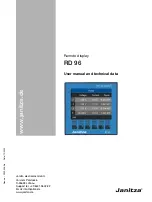
Chapter 5
Setup and Configuration
RUGGEDCOM ROX II
User Guide
368
Linux netfilter
always open, and connections are not opened or closed based on outside criteria. Static IP filters offer no form of
authentication.
Stateful
or session-based firewalls add considerably more complexity to the firewalling process. They track the
state of each connection, look at and test each packet (connection tracking), and recognize and manage as a
whole traffic from a particular protocol that is on connected sets of TCP/UDP ports.
Section 5.17.1.2
Linux netfilter
Netfilter, a subsystem of the Linux kernel, is a stateful firewall that provides the ability to examine IP packets on a
per-session basis.
Netfilter uses rulesets, which are collections of packet classification rules that determine the outcome of the
examination of a specific packet. The rules are defined by iptables, a generic table structure syntax and utility
program for the configuration and control of netfilter.
ROX implements an IP firewall using a structured user interface to configure iptables rules and netfilter rulesets.
Section 5.17.1.3
Network Address Translation
Network Address Translation (NAT) enables a LAN to use one set of IP addresses for internal traffic and a
second set for external traffic. The netfilter NAT function makes all necessary IP address translations as traffic
passes between the Intranet and the Internet. NAT is often referred to in Linux as IP Masquerading.
NAT itself provides a type of firewall by hiding internal IP addresses. More importantly, NAT enables a network
to use more internal IP addresses. Since they are only used internally, there is no possibility of conflict with IP
addresses used by other organizations. Typically, an internal network is configured to use one or more of the
reserved address blocks described in RFC1918.
Table: RFC1918 Reserved IP Address Blocks
IP Network/Mask
Address Range
10.0.0.0/8
10.0.0.0 – 10.255.255.255
172.16.0.0/12
172.16.0.0 – 172.31.255.255
192.168.0.0/16
192.168.0.0 – 192.168.255.255
When a packet from a host on the internal network reaches the NAT gateway, its source address and source
TCP/UDP port number are recorded. The address and port number is translated to the public IP address and
an unused port number on the public interface. When the Internet host replies to the internal host's packet, it is
addressed to the NAT gateway's external IP address at the translation port number. The NAT gateway searches
its tables and makes the opposite changes it made to the outgoing packet. NAT then forwards the reply packet to
the internal host.
Translation of ICMP packets happens in a similar fashion, but without the source port modification.
NAT can be used in static and dynamic modes. Static NAT (SNAT) masks the private IP addresses by translating
each internal address to a unique external address. Dynamic NAT translates all internal addresses to one or more
external addresses.
Summary of Contents for RUGGEDCOM RX1510
Page 32: ...RUGGEDCOM ROX II User Guide Preface Customer Support xxxii ...
Page 44: ...RUGGEDCOM ROX II User Guide Chapter 1 Introduction User Permissions 12 ...
Page 62: ...RUGGEDCOM ROX II User Guide Chapter 2 Using ROX II Using the Command Line Interface 30 ...
Page 268: ...RUGGEDCOM ROX II User Guide Chapter 4 System Administration Deleting a Scheduled Job 236 ...
















































